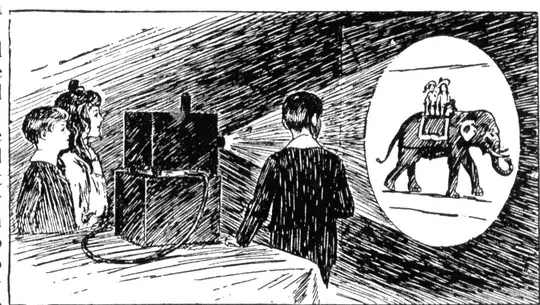Anime production nowadays is now pretty much complicated and technologically advanced.
I'm curious as to how was anime production back then back in the old days when it was still obscure?
Anime production nowadays is now pretty much complicated and technologically advanced.
I'm curious as to how was anime production back then back in the old days when it was still obscure?
The very first anime (see more) - Katsudō Shashin was sketched onto a celluloid strip using a kappa-ban for a Magic Lantern, adjusted for continuous play.
 (Arthur Mee and Holland Thompson, eds. The Book of Knowledge (New York, NY: The Grolier Society, 1912))
(Arthur Mee and Holland Thompson, eds. The Book of Knowledge (New York, NY: The Grolier Society, 1912))
Previously, the magic lantern had been occasionally been used to tell stories, but none in a fluid manner like Katsudo Shashin. It's claim to be the 'first anime' is still debated due to many things, including its length.
The basic principle of the Magic lantern is magnification through a convex lens. This meant however, that slides were put in upside down in order to be projected at the correct orientation.
The origins of the Magic lantern are estimated to lie in the 17th century,
Whilst Magic Lanterns fell out of use, celluloid sheets continued to be used for many years, until they were eventually replaced by digital methods.
These links give details about the history of anime production
Few quotes from links are given
https://en.wikipedia.org/wiki/Anime#History
Japanese animation began in the early 20th century, when Japanese filmmakers experimented with the animation techniques also pioneered in France, Germany, the United States and Russia.
The success of The Walt Disney Company's 1937 feature film Snow White and the Seven Dwarfs profoundly influenced many Japanese animators. In the 1960s, manga artist and animator Osamu Tezuka adapted and simplified many Disney animation techniques to reduce costs and to limit the number of frames in productions.
https://en.wikipedia.org/wiki/History_of_anime
Few complete animations made during the beginnings of Japanese animation have survived. The reasons vary, but many are of commercial nature. After the clips had their run, reels (being property of the cinemas) were sold to smaller cinemas in the country and then disassembled and sold as strips or single frames.
A 3-second film loop tentatively titled Katsudō Shashin was likely produced between 1907 and 1911 and discovered in Kyoto in July 2005. It consists of fifty frames stenciled directly onto a strip of celluloid.
Its said that the 1923 Great Kantō earthquake destroyed most of the works.